It can be tough to translate evidence into action in education research.
A principal or superintendent might sift through academic journals or vendorsâ pamphlets for an effective reading program, but even a seal of approval from the federal What Works Clearinghouse is no guarantee that what helped students in one district will be successful with another.
To better inform that knowledge base, the Institute of Education Sciences is crafting a new research program, called âcontinuous improvement research in education,â to go beyond âwhat worksâ and add more context to education findings.
âKnowing what works plays a very important role in school improvement, but alone itâs not enough,â said John Q. Easton, the director of the IES, the research arm of the U.S. Department of Education. âThere are questions about building the capacity to implement what works, building the capacity to measure, check, and adapt to changes.â
The initiative, expected to be launched in 2014, would award four-year grants of up to $1.5 million each, though thereâs no word yet on how many would be awarded. The IES wants researchers to focus on supportive school climates, high school transitions, or access to postsecondary education.
The initiative would build in part on a slew of new research models. They include"design-based implementation research"âbeing developed at Vanderbilt Universityâs National Center on Scaling Up Effective 69´«Ã½, in Nashville, Tenn., and SRI Internationalâs Center for Technology in Learning, in Menlo Park, Calif.âand the ârapid prototypingâ models tested at the Carnegie Foundation for the Advancement of Teaching, in Stanford, Calif., and the Institute for Healthcare Improvement, in Cambridge, Mass.
In both models, researchers and districts work together over years to identify and test solutions for specific problems.
âIterativeâ Research
"[In] a typical research project, hereâs my research question; Iâm going to answer my research question. This is much more iterative, developed collaboratively, and youâre not sure how itâs going to go or what the time frame is,â said Bridget T. Long, a Harvard University education economist and the president of the National Board for Education Sciences, which advises the IES and discussed the proposed initiative at a meeting here in Washington on Oct. 5.
Mr. Easton said the initiative would focus on cycles of improvement, in which researchers develop, test, and tweak interventions in the classroom or school context. (âResearchers Seek Faster Answers to Innovation Questions,â Jan. 12, 2011.)
For example, NBES member Hirokazu Yoshikawa, the academic dean at the Harvard Graduate School of Education, said he used rapid prototyping, which includes 90-day, intervention-testing cycles, to adapt a teacher professional-development program in Chile.
The method was, Mr. Yoshikawa said, âspectacularly successful in achieving buy-in and local ownership, but also, from a scientific standpoint, getting to a part of the science that I donât think weâd ever gotten to, which is how do you track the day-to-day or week-to-week improvement process?â
âIt creates local tests of change,â he said, âand itâs the practitioners who develop those methods themselves.â
The projects would also focus on systemwide interventions, âexamining how components of systems work together to generate desired outcomes,â according to the draft request for proposals.
Prior federal research has pointed to local context as a sticking point for scaling up successful educational interventions. Recent federal longitudinal studies of school improvement found district policies and supports can mean the difference between schools that turn around and those that struggle.
Careful Collaboration
Anthony S. Bryk, an NBES member and the president of the Carnegie Foundation for the Advancement of Teaching, likened continuous-improvement research to the Toyota auto companyâs famed âtotal quality managementâ system, in which any worker can stop the factory line if he spots a problem.
âWhat is the problem weâre trying to solve, what and why is the change weâre putting in place, and how will we know if that change is an improvement?â Mr. Bryk said, describing the approach continuous-improvement research takes.
âThatâs a very different way of thinking about the work,â he said. âItâs seeing improvement as a learning journey, rather than the way most districts see it as, âWell, we have this new idea, I have to roll it out fast, implement it at scale, and most of my attention is on crisis intervention.â â
Barbara Means, the director of SRI International, cautioned that the federal research agency will have to structure the grants to force educators and researchers to be equal collaborators, in which âneither can totally steer the ship, but both must be accountable.â
The IES has already been building up the supply of research partnerships that might be capable of taking up the work. The new network of federally financed regional educational laboratories has developed some 70 research alliances involving states, districts, and researchers.
âWhatâs become really clear is this is really hard work,â said Ruth C. Neild, the commissioner of the National Center on Education Evaluation, part of the IES. âEngaging over a sustained time is harder for researchers, harder for districts and states, but we think the rewards will be greater.â
If successful, said NBES member Robert Granger, the president of the New York City-based William T. Grant Foundation, the initiative could produce a new gold-standard model for education research, akin to the IESâ original focus on randomized controlled trials, but âwhere the gold standard isnât to run a trial; the gold standard is seeing consistent results across a number of conditions.â




